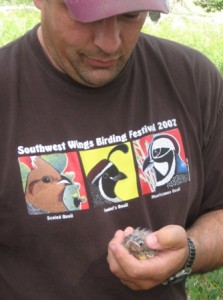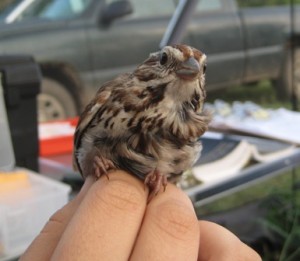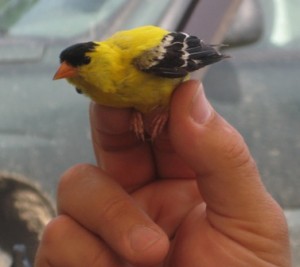Last Friday morning (4:00 AM to be exact), Amy and I very sleepily headed out to our Canyon Creek banding station, with John taking the reins driving the pickup. All in all, we’ve had a very productive season, and that Friday was no exception; we banded a total of 18 birds, 14 of which we caught in our nets. We caught a few new species–a Song sparrow (present year-round at the BFS in Claremont), American goldfinches, and a Chipping sparrow. In fact, we haven’t even observed the Song or Chipping sparrows at our site until that day. The American goldfinches were a fun catch–four goldfinches had simultaneously flown into net 8 and formed a tight little square of bright yellow blobs in the two lower trammels.
We’re approaching the end of the breeding season, so we expect to see more and more hatch years (chicks born this calendar year) as the summer progresses. We’ve also had quite a few recaptures, which form the basis of survivorship estimates. The same brown thrasher continually gets caught at net 10, and we’ve had quite a few House wren recaptures.
Finally, four of the birds that we banded were the Western meadowlark nestlings that Amy and I have been monitoring through the season. These nestlings, like most bird chicks, are hideous; they are all awkward protruding joints, pin feathers, and bare skin. However, they do inspire quite the protective urge (as you’ll see in Amy’s post about our rescue of a potential House Sparrow/Brown-headed cowbird chick [I hope it’s a cowbird]) because they are so completely helpless, and try to use their nubs of wings to cover their heads. They are simultaneously ugly, pathetic, and adorable–in short, a face that only a mother (or a birder) could love.

John holding a just-banded Western meadowlark chick. Note the pin feathers (the small feathery tufts sticking out of prominent shafts).
It’ll be intriguing to study these little chicks’ survivorships. According to John Carlson, the first year is typically the hardest year overall for birds to survive. He cites the example of Emperor penguins in Antarctica–if nestlings manage to make it past the first year, then they can live to be 10+ years old, but the great challenge is getting through that first year. Hopefully they’ll make it, and with any luck, John and other students can recapture them in the future.


